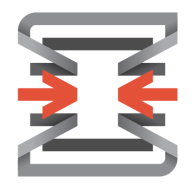


OPNsense and FortiGate NGFW are competitive firewall solutions with distinct strengths. Based on the data comparisons, FortiGate NGFW seems to have the upper hand due to its superior security features and performance in large-scale environments.
Features: OPNsense offers advanced routing, VPN capabilities, and has a strong open-source community. FortiGate NGFW provides comprehensive threat intelligence, high throughput, and integration with other Fortinet products.
Room for Improvement: OPNsense users indicate needs for better documentation, more intuitive configurations, and streamlined user resources. FortiGate NGFW users suggest improvements in licensing complexity, interface ease-of-use, and reduced complexity for smaller IT teams.
Ease of Deployment and Customer Service: OPNsense is praised for its straightforward deployment process and strong community support. FortiGate NGFW is noted for its comprehensive deployment options but receives mixed reviews regarding its customer support responsiveness.
Pricing and ROI: OPNsense is known for its cost-effectiveness, offering solid performance at a lower price point. FortiGate NGFW, despite being more expensive, delivers high ROI through its extensive features and reliability.
Clients are now comfortable and not wasting productive hours on IT support.
The automation part is giving us a cost benefit and speed; we can react faster.
It's a very useful tool to mitigate and protect your enterprise.
It has notably improved our efficiency and visibility.
Using FortiGate has enabled us to increase security, control user access, manage bandwidth, and enhance the ability to provide a variety of operations solutions to clients.
It's easy to configure a new connection, and it works in a few minutes if everything works fine.
The network attacks reduced by approximately 60% after using that, even without customizing the custom configuration yet.
For a very little investment, I was able to increase the security of my network.
They offer very accurate solutions.
The quick resolution of issues with Fortinet FortiGate is due to the support of the company and the fact that the equipment is easy to work with.
I would rate the technical support for Fortinet FortiGate a ten out of ten.
I must study the best version to install to avoid previously found bugs.
I would rate Fortinet's support a 10 because they are excellent and very available whenever we needed their help.
In some cases, you need to come prepared because the people there work by the book and ask for particular things. If you don't have them, you cannot proceed, but if you know what they need, after some time, it's pretty easy to get support or whatever you need.
Compared to some open-source projects with weak support, OPNsense stands out for having both a strong community and commercial backing options.
I mainly rely on community support since the solution is open source.
OPNsense is open source, so you have to rely on the community for customer support.
They scale up really well from smaller models like the FortiGate 40 and 50 to bigger sites with the FortiGate 100 for more throughput - up to enterprise datacenters.
The variation comes in terms of the interfaces and throughputs, but from a security perspective, you get the same benefit, irrespective of whether you have an entry-level unit or an enterprise.
We determine sizing based on multiple factors: number of users, available links, traffic types, server count, services in use, and whether services will be published.
The scalability of the FortiGate Next Generation Firewall (NGFW) is quite good; it is easy to make it scalable.
What it allows us in terms of connections to other companies is a straightforward solution that you don't have to use something else.
Aside from these aspects, it demonstrated good scalability.
It supports routing, VPN setups, and traffic monitoring with additional packages like Snort and Suricata.
OPNsense is an extremely scalable solution.
We're experiencing 99.999% availability consistently.
I would rate the stability of Fortinet FortiGate a ten out of ten.
Currently, we are experiencing a general outage of one of the main internet service providers of the Dominican Republic, and we have not been impacted in our operations because with SD-WAN, we have another internet service provider and we are working with the second WAN connection without any disruption.
Regarding next-generation firewalls, I would give the FortiGate Next Generation Firewall (NGFW) a rating of 10 for stability.
In some cases, you need to restart it, but mostly, it's working flawlessly, especially if you have an HA environment, high availability.
In my experience, there are usually no significant stability issues with FortiGate Next Generation Firewall (NGFW).
For home and small network use, OPNsense is also reliable, providing enterprise-grade security at no cost.
OPNsense is the same, but it does have a way of installing the Realtek drivers, which gives you a lot more stability overall on the system.
The only challenge faced was its inadequacy to manage large voice traffic effectively, even with dedicated hardware.
Investing in a solution that can accommodate such growth would be more cost-effective than repeatedly purchasing new hardware.
While Fortinet claims to offer a comprehensive network solution, it falls short in addressing computer application issues, particularly server security.
When considering Sophos XG, which we also use, the logging and reporting functionality is notably more efficient.
Improvements could be made when companies expand and need better equipment and more licenses.
Configuring these services is quite complex and not very user-friendly, requiring technical steps that are difficult for normal users to understand.
When a site is blocked, it is necessary for me to consult the logs to understand what the Next Generation Firewall policy has blocked.
For high availability, it's crucial to have a method in place where a designated component oversees the entire process.
Improved guidance on package usage and integration beyond relying on external tutorials or community support would be beneficial.
I would like the APIs to be more mature and more developed and have more options to automate threat hunting.
Last year, I renewed the support for three years, which can sometimes be expensive but depends on the security benefits and how it helps us.
It is about 20% cheaper.
The advantages of Fortinet FortiGate over its competitors include good pricing and meeting our requirements at a lower cost.
It offers cost savings as it is generally cheaper than the competition.
The pricing of FortiGate Next Generation Firewall is competitive.
Fortinet tools like FortiGate are costly for us as a higher education institute in India.
It is a free solution, and when you compare it to alternatives like FortiGate, which is quite powerful but also costly, the value becomes evident.
I would rate the pricing a nine out of ten, especially considering the availability of a free community edition.
It is free.
In terms of security, we have not experienced any security flaws or loopholes, and it has proven to be quite stable.
FortiGate has helped reduce the risk of cyberattacks that might disrupt our client's production.
These features help reduce our downtime, manage the ISPs, and deploy SLAs for all the website traffic.
The firewall and VPN features are the most valuable in protecting our customers' networks.
The most valuable features of the FortiGate firewall include SSL inspection, VPN functionality, and threat intelligence features for preventing threats.
FortiGate Next Generation Firewall (NGFW) has improved our efficiency in setting up security and provided us with more visibility over some issues and incidents we previously faced.
The most valuable features include the basic firewall functionality and the GeoIP location services.
I can have a Wi-Fi VLAN and feel secure that the server network or the VM network that I have on a different VLAN are isolated, and they cannot talk to one another, which adds a great level of security.
It offers enterprise-grade features such as intrusion detection and prevention system, VPN support, traffic shaping, and web filtering, all without license cost.
| Product | Market Share (%) |
|---|---|
| Fortinet FortiGate | 20.1% |
| OPNsense | 11.1% |
| FortiGate Next Generation Firewall (NGFW) | 0.8% |
| Other | 68.0% |



| Company Size | Count |
|---|---|
| Small Business | 261 |
| Midsize Enterprise | 99 |
| Large Enterprise | 143 |
| Company Size | Count |
|---|---|
| Small Business | 38 |
| Midsize Enterprise | 11 |
| Large Enterprise | 7 |
| Company Size | Count |
|---|---|
| Small Business | 30 |
| Midsize Enterprise | 4 |
| Large Enterprise | 8 |
Fortinet FortiGate offers comprehensive network security and firewall protection across multiple locations. It effectively manages data traffic and secures environments with features like VPN, intrusion prevention, and UTM controls.
Organizations rely on Fortinet FortiGate for its robust integration with advanced security policies, ensuring significant protection for enterprises, cloud environments, and educational sectors. It facilitates network segmentation, application-level security, and authentication management, securing communication within and between locations such as branches and data centers. Its efficient SD-WAN and UTM features enable streamlined data management and enhanced threat protection capabilities. Users appreciate its centralized management, facilitating seamless operations across diverse environments.
What are the key features of Fortinet FortiGate?
What benefits should users expect from Fortinet FortiGate?
Fortinet FortiGate is crucial in sectors like education, offering robust networks for secure data flow between campuses and facilitating remote learning. In enterprise environments, it allows efficient management of application traffic and security across multiple branches, while in the cloud, it seamlessly integrates with diverse platforms to enhance security infrastructure.
The FortiGate Next Generation Firewall (NGFW) from Fortinet is a comprehensive cybersecurity solution designed to cater to a wide array of organizational needs. It integrates seamlessly into the Fortinet Security Fabric, offering robust protection against various internal and external threats, including attacks, malware, and vulnerabilities. The NGFW is known for its advanced features such as SSL inspection, application control, visibility enhancements, and an effective intrusion prevention system (IPS). This IPS plays a critical role in identifying and blocking malicious traffic by monitoring and inspecting incoming data.
FortiGate NGFW can be deployed in diverse environments, including on-premises, in the cloud, or hybrid setups. The firewall is equipped with next-generation antivirus capabilities, IPS, web filtering, sandboxing, and intelligent security automation features like threat intelligence integration and automated incident response. Its reporting and analytics tools are comprehensive, aiding in enhancing an organization's security posture.
A notable aspect of the FortiGate NGFW is its diverse and highly rated features, including a powerful VPN, a user-friendly Firewall Management Console, policy-based controls, and advanced reporting and logging capabilities. The system also supports Identification Technologies, Visualization Tools, Content Inspection, and seamless integration with Active Directory and LDAP directories. Its High Availability and the flexibility to deploy in various configurations, such as on-premises or as a Virtual Machine, make it a versatile choice for different business needs.
The FortiGate NGFW also excels in providing secure connectivity. It supports various VPN protocols, offers SD-WAN for intelligent traffic routing, and integrates SASE for unified security and networking solutions. These features contribute to improved security, reduced operational costs, and increased agility for organizations.
When it comes to user experiences and satisfaction, FortiGate NGFW has garnered positive feedback, with an average rating of about 4.26 out of 5 on PeerSpot Reviews. Users from diverse roles, including core network teams, technical officers, and cybersecurity engineers, and from various sectors such as tech services, education, and finance, have found the solution effective. This indicates its versatility and suitability across different company sizes and types.
However, there are areas for improvement. Enhancing the details in Logging Services and making 10 Gigabit Interfaces available for lower models are some suggested enhancements. Simplifying the installation of FortiAP services is also noted as a potential area for improvement.
OPNsense is widely used for firewall functionalities, intrusion detection, VPN and IPSec, content filtering, securing network traffic, and remote access. It protects internal networks and manages servers securely, suitable for small to medium-sized businesses.
OPNsense is a comprehensive firewall solution leveraging open-source technology. It integrates with third-party modules like WireGuard and CrowdSec, enhancing its security capabilities. Offering on-premises and cloud deployment, it features an intuitive graphical interface, advanced reporting, VPN functionality, IDS/IPS features, and high scalability. Users find it ideal for small businesses and home networks due to its stability and ease of use. Frequent updates and an active community support its continuous improvement. However, it needs advancements in VPN selection, scalability, and technical documentation. Enhanced high availability, threat intelligence, and integration with virtualization platforms are required. User feedback suggests improvements in connectivity, alerting, traffic monitoring, and antivirus protection.
What are the key features of OPNsense?OPNsense is implemented across various industries to secure network infrastructure and ensure reliable connectivity. In fintech, it safeguards sensitive financial data while maintaining compliance. Educational institutions deploy it to protect student information and enable secure remote learning environments. Healthcare organizations use it to secure patient data and comply with HIPAA regulations. By integrating with tools like WireGuard and CrowdSec, businesses enhance their cybersecurity posture and streamline network management, making OPNsense a versatile choice for diverse operational needs.
We monitor all Firewalls reviews to prevent fraudulent reviews and keep review quality high. We do not post reviews by company employees or direct competitors. We validate each review for authenticity via cross-reference with LinkedIn, and personal follow-up with the reviewer when necessary.